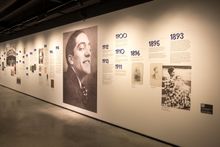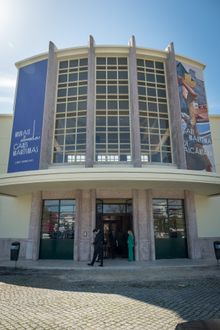 09 Apr 2025
09 Apr 2025
Lisbon's cultural and tourism scene welcomes a new highlight today with the opening of the Interpretive Centre “Almada's Murals in the Maritime Stations”, a space dedicated to the monumental work of Almada Negreiros. The centre was inaugurated yesterday, April 7, the date celebrating the artist's birth, and opens to the public today, providing visitors with access to the emblematic murals in the Alcântara and Rocha do Conde de Óbidos Maritime Stations - buildings designed by architect Porfírio Pardal Monteiro and inaugurated in the 1940s.
This new project, promoted by the Lisbon Tourism Association in partnership with Lisbon City Council and the Port of Lisbon Administration, reveals the history of the Maritime Stations and the life and work of Almada Negreiros. It showcases the largest and most significant collection of 20th-century mural paintings in Portugal.
Carlos Moedas, the Mayor of Lisbon, says that "opening the Maritime Stations to the public is another step in the valorisation of the city's heritage. With this Interpretive Centre, Lisbon residents and tourists will finally have access to one of the greatest works of Portuguese modernism."
For his part, Hugo Espírito Santo, Secretary of State for Infrastructures, highlighted that “the Interpretive Centre for Almada's Murals in the Maritime Stations represents a new chapter in the Port of Lisbon's relationship with the city and its people. It marks another stage in the rehabilitation of the maritime stations and the enhancement of Almada Negreiros' murals, and reaffirms the commitment to the preservation and promotion of this important historical and cultural heritage of Portugal”.
Located on the ground floor of the Alcântara Maritime Station, the Interpretive Centre features nine rooms where visitors can embark on a journey through the history of the Port of Lisbon, the importance of building the Maritime Stations and Almada Negreiros' creative process in creating the murals in the 1940s.
The “Cais”, “Passagens”, “Partidas” and “Chegadas” rooms showcase the history of the construction of the Alcântara and Rocha do Conde de Óbidos maritime stations, as well as their role in several historical events such as the Second World War, emigration, the Colonial War and the subsequent decolonisation and return of the Portuguese from the former colonies.
The rooms “O que contam as paredes”, “História mural” and “Diz que disse” are dedicated to the mural paintings in both maritime stations, the entire creative process behind them and Almada's interviews and statements during and after their completion.
Finally, the “Almada em Lisboa” and “Almada Negreiros, artista” rooms showcase key moments from Almada Negreiros' life and work, as well as locations in Lisbon where his works can be found.
On the first floor of both stations, visitors will be able to see the murals of the Alcântara and Rocha do Conde de Óbidos Maritime Stations, which are open to the public for the first time, in an audio-guided tour.
The restoration of the murals at Rocha do Conde de Óbidos Maritime Station was recently completed with funding secured from the World Monuments Fund, a non-profit organisation whose mission is to safeguard irreplaceable cultural heritage around the world. The Fund's biannual programme, World Monuments Watch, selects 25 places in different locations with notable historical and artistic relevance.
The “Almada Murals at the Maritime Stations” Interpretive Centre reinforces Lisbon's cultural and touristic offer, on the Alcântara-Belém axis. It is open daily from 10am to 7pm, with tickets priced at €5 - free with the Lisboa Card. Free transport between the two stations, located 800 metres apart, will be provided by a purpose-built vehicle based on the original luggage trolley project, designed by the studio of the architect Porfírio Pardal Monteiro.
The design and coordination of the Interpretive Centre's contents is the responsibility of Mariana Pinto dos Santos, art historian and independent curator, lecturer at the NOVA Faculty of Social Sciences and Humanities, integrated researcher at the NOVA FCHS Art History Institute and the associated IN2PAST Laboratory.
The project has the collaboration of the artist's granddaughters, Rita Almada Negreiros and Catarina Almada Negreiros, the Almada Negreiros Study and Documentation Centre - Sarah Affonso (NOVA FCSH), the NOVA FCSH Art History Institute, the HERCULES Laboratory and the Calouste Gulbenkian Foundation, among other entities.
The project, totalling 3.5 million euros, was funded by Turismo de Portugal as part of the Casino Lisboa Works Plan, the Lisbon Tourism Association and the Entidade Regional de Turismo da Região de Lisboa.
Images here
Website: www.muraisalmadagaresmaritimas.pt
Notes to editors: Biography of Almada Negreiros
Ends
Notes to editors
Life and work of Almada Negreiros
José Sobral de Almada Negreiros was a polyhedral artist who marked modernity in Portugal with his writing, theatre, dance and various plastic arts. He was born in São Tomé in 1893. After his mother died in 1896, he grew up and was educated in Lisbon with his brother António at the Jesuit boarding school in Campolide.
In 1913, Almada held his first solo exhibition of humorous drawings. He was a contributor to the avant-garde literary magazine Orpheu, founded by poets Fernando Pessoa and Mário de Sá-Carneiro in 1915.
He was part of the Futurist avant-garde in Portugal, which was characterised by its strong performative nature, and wrote four artistic manifestos. In 1917, he published the novella A Engomadeira (1917), the futurist short story K4 O Quadrado Azul (1917) and the short story Saltimbancos (Contrastes Simultâneos) (1916).
The 1910s and 1920s were a fertile time for collaborations and projects, in a desire to break with the past that found new expression with the liberation of customs and the bohemian life of the 1920s, which was once again hampered by the military coup of 1926 that established a dictatorship in Portugal.
In 1919 he went to Paris, where he lived for a year. The experience of this trip resulted in the poetic conference A Invenção do Dia Claro (1921). In 1925 he wrote his novel, Nome de Guerra, which he forgot in a drawer and didn't publish until 1938. In the 1920s, he wrote several theatre plays, some of which he didn't publish until thirty years later.
In 1927, he left for Madrid, where he lived until 1932. He established himself on the Madrid art scene with solo and group exhibitions, always collaborating with musicians, writers and architects. Almada Negreiros left Spain when the Estado Novo was formed and António de Oliveira Salazar came to power (1933).
The dictatorship's cultural policy implemented a new way of working for artists, who became dependente on state commissions. Responding to public and some private commissions, he made stained glass windows, tiles and mural paintings, among other works, mainly in collaboration with the architect Porfírio Pardal Monteiro. These works sparked his interest in geometry and his self-taught studies later led him to abstract geometric painting. In 1934, he married the painter Sarah Affonso, with whom he had two children.
In the 1940s he was asked to do the controversial murals for the Alcântara and Rocha do Conde de Óbidos Maritime Stations in Lisbon, which he finished in 1949. In 1954 he did the first of two famous iconic portraits of Fernando Pessoa. His last commission was the incised geometric drawing panel in stone, Começar (1968), for the Calouste Gulbenkian Foundation. He died in Lisbon on 15 June 1970 at the Hospital de São Luís dos Franceses.
About Turismo de Lisboa
Turismo de Lisboa is a non-profit organisation established through an alliance of public and private bodies operating in the tourist sector. It has around 900 associated members. Since its inception in 1998, the main objective of this association is to improve and increase the promotion of Lisboa as a tourist destination and therefore enhance the quality and competitiveness of the city.
For media information and images, please contact Hume Whitehead Ltd:
Laura Boo (laura@humewhitehead.co.uk / 020 3375 4056)
Richard Hume (richard@humewhitehead.co.uk / 020 3375 4050)




